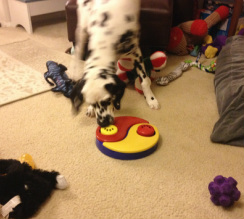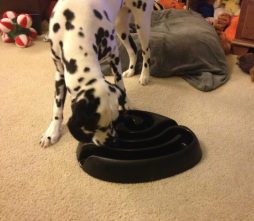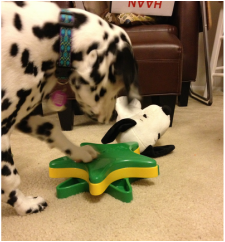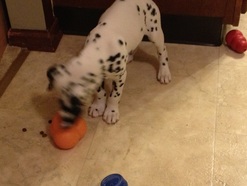A 12-Step Plan For Dealing with
Separation Anxiety
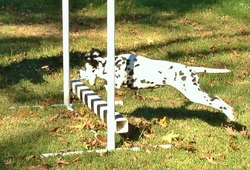
1. Exercise, Exercise, Exercise
Provide adequate daily exercise - at least 30 minutes of running or playing - twice a day. For super high energy pets, give them a job! This may be something as easy as wearing a back pack on walks to training them to pull a cart or sled. Many dogs enjoy obedience and agility classes.
We set up some agility jumps for Saoirse in the back yard to help keep her running!
Provide adequate daily exercise - at least 30 minutes of running or playing - twice a day. For super high energy pets, give them a job! This may be something as easy as wearing a back pack on walks to training them to pull a cart or sled. Many dogs enjoy obedience and agility classes.
We set up some agility jumps for Saoirse in the back yard to help keep her running!
2. Interactive Toys
Provide interactive toys for your pet when leaving and also when staying at home (this way your pet won't associate them with being left alone). Try putting a small amount of peanut butter in a Kong toy to hold treats or kibble in place for longer periods of time. Other good interactive toys include the Buster Cube, Molecule Ball, and . I haven't tried any of Nina Ottossen's line of interactive toys yet, but they look promising! (Update: Adult Saoirse uses several of the Trixie puzzles as well as the Nina Ottossen puzzles, which are a bit harder!) Saoirse and I really like the interactive toys by Kyjen, but they aren't strong enough for unsupervised use for her. Making a DIY "Snuffle Mat" is a GREAT way to keep dogs busy for dinner time and expend some mental energy.
Provide interactive toys for your pet when leaving and also when staying at home (this way your pet won't associate them with being left alone). Try putting a small amount of peanut butter in a Kong toy to hold treats or kibble in place for longer periods of time. Other good interactive toys include the Buster Cube, Molecule Ball, and . I haven't tried any of Nina Ottossen's line of interactive toys yet, but they look promising! (Update: Adult Saoirse uses several of the Trixie puzzles as well as the Nina Ottossen puzzles, which are a bit harder!) Saoirse and I really like the interactive toys by Kyjen, but they aren't strong enough for unsupervised use for her. Making a DIY "Snuffle Mat" is a GREAT way to keep dogs busy for dinner time and expend some mental energy.
|
The Yin Yang Yum by Kyjen
The Buster Dog Maze - Brilliant!
|
The Star Spinner Puzzle Toy by Kyjen
Little puppy Saoirse playing with a Molecule ball (with a Kong toy in the background and part of an Everlasting Treat Ball in the foreground!)
|
3. Desensitization
Start desensitization (ie shaking keys, putting on shoes, going through the routine of getting ready to leave the house). Do this several times before actually leaving the house, but also do it when you are going to be staying at home. For example, if your dog associates you putting on your shoes with you leaving the house, then begin putting them on and taking them off several times throughout the day without leaving. The purpose is to get your dog used to the activity so that it no longer triggers the anxiety associated with your departure. A combination of these triggers are adding up to make your dog super anxious before you even get to the point that you leave the house.
Start desensitization (ie shaking keys, putting on shoes, going through the routine of getting ready to leave the house). Do this several times before actually leaving the house, but also do it when you are going to be staying at home. For example, if your dog associates you putting on your shoes with you leaving the house, then begin putting them on and taking them off several times throughout the day without leaving. The purpose is to get your dog used to the activity so that it no longer triggers the anxiety associated with your departure. A combination of these triggers are adding up to make your dog super anxious before you even get to the point that you leave the house.
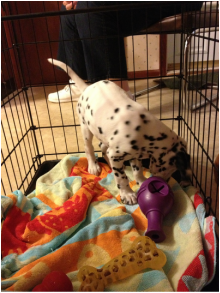
4. Area of Confinement
Set up an area of confinement for your pet. This may be a crate or a restricted area in the house where he will stay when you are out of the house. Make this a special or safe place where good things happen. You can give treats and/or feed your pet in this area to help associate positive feelings. Leave the crate or area open when you are home so your pet can go in/out and doesn't always associate it with being left. Make sure the area is "dog-proofed" (free of tempting items like shoes, trash and laundry). Even in a crate, nearby items may not be safe if they can be reached! (I learned the hard way when Saoirse pulled a large section of bedspread through a tiny hole in the crate.)
5. Crating
Try putting your pet in his crate or special/safe area for short periods of time when you are still in the house and not planning on leaving. Then gradually extend the amount of time your pet is in there when you're in the house. Mix it up with short trips to the bank, grocery store, etc. Gradually extend the time your pet is in his crate when you are out of the house. This way your pet doesn't associate the crate or safe area with always being left for long periods of time.
Set up an area of confinement for your pet. This may be a crate or a restricted area in the house where he will stay when you are out of the house. Make this a special or safe place where good things happen. You can give treats and/or feed your pet in this area to help associate positive feelings. Leave the crate or area open when you are home so your pet can go in/out and doesn't always associate it with being left. Make sure the area is "dog-proofed" (free of tempting items like shoes, trash and laundry). Even in a crate, nearby items may not be safe if they can be reached! (I learned the hard way when Saoirse pulled a large section of bedspread through a tiny hole in the crate.)
5. Crating
Try putting your pet in his crate or special/safe area for short periods of time when you are still in the house and not planning on leaving. Then gradually extend the amount of time your pet is in there when you're in the house. Mix it up with short trips to the bank, grocery store, etc. Gradually extend the time your pet is in his crate when you are out of the house. This way your pet doesn't associate the crate or safe area with always being left for long periods of time.
6. Preparing to Leave
When preparing to leave the house, do not administer excessive attention (try to ignore your pet) to encourage calm behavior for 20-30 minutes prior to your departure.
When preparing to leave the house, do not administer excessive attention (try to ignore your pet) to encourage calm behavior for 20-30 minutes prior to your departure.
7. Returning Home
When returning home, stay calm and do not administer excessive attention (try to ignore your pet) for 20-30 minutes until he is calm.
When returning home, stay calm and do not administer excessive attention (try to ignore your pet) for 20-30 minutes until he is calm.
8. Reward Calm Behavior
While in the house, only administer attention when your pet is in a calm state of mind. Make sure that YOU are the one initiating contact. Ignore attention seeking behavior like pawing, nosing, jumping up and barking. I know, easier said than done. But you CAN do this.
While in the house, only administer attention when your pet is in a calm state of mind. Make sure that YOU are the one initiating contact. Ignore attention seeking behavior like pawing, nosing, jumping up and barking. I know, easier said than done. But you CAN do this.
9. Daily Training
Consider enrolling in obedience or agility classes. This provides mental and physical stimulation and also helps build self esteem. Ten minutes a day of practice will also help build the bond between you and your pet and increase his confidence in you as the pack leader.
Consider enrolling in obedience or agility classes. This provides mental and physical stimulation and also helps build self esteem. Ten minutes a day of practice will also help build the bond between you and your pet and increase his confidence in you as the pack leader.
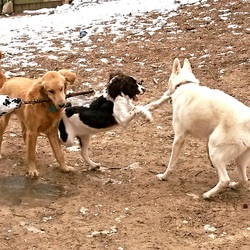 Saoirse and her Doggie Day Care buddies
Saoirse and her Doggie Day Care buddies
10. Consider Doggie Day Care
Consider Doggie Day Care several times a week. This is a great outlet to blow off steam and interact with fellow canines. It also allows dogs to be supervised and prevents them from getting into trouble. Not all Doggie Day Care is the same -- call to speak to the coordinator of the facility to find out what kind of activities your dog will be involved in, and how much time is spent playing vs crated. Some locations will want to meet you and your dog if you have not been there for training classes previously (I think this is a great idea).
11. Neutraceuticals, Pharmaceuticals & Pheremones
- D.A.P. - dog appeasing pheremone - Adaptil. I highly recommend the DAP spray, DAP diffuser, and a Adaptil collars. Both the diffuser and collar last 30 days. DAP is the pheremone that mother dogs release when they are nursing to help relax the puppies. It is great for puppies in training, as well as adult dogs that are fearful or anxious.
12. Consider seeing a behavioral specialist.
